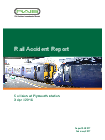Report 02/2017: Collision at Plymouth station
RAIB has today released its report into a collision at Plymouth station, 3 April 2016.

The two trains after the accident: 2E68 on the left (courtesy BTP)
Summary
At 15:34 hrs on Sunday 3 April 2016, the 13:39 hrs passenger train service from Penzance to Exeter collided with an empty train which was already waiting in platform 6 at Plymouth station. The collision occurred at a speed of about 15 mph (24 km/h) and resulted in injuries to 48 people and damage to both trains.
The signaller intended that both trains should share the platform because the empty train was to form a service to London and some passengers from the Penzance service were expected to join it. Lift refurbishment work meant that without platform sharing, passengers would have needed to use the stairs and a subway when changing trains. Permissive signalling arrangements were in place at Plymouth to permit two trains to share the same platform.
The signaller misjudged the amount of space available behind the London train and wrongly believed there was room for the Penzance train. He was aware that the platform sharing arrangement required an unusual form of permissive working, but did not communicate this to the Penzance train driver, and the rules did not require him to do so.
The Penzance train driver incorrectly believed he would not be sharing a platform with the London train. There was insufficient distance to stop his train by the time he realised his mistake and had applied the emergency brake.
Great Western Railway, the operator of both trains, and Network Rail the owner of the infrastructure, had not identified the risk of a collision due to the combination of an unusual form of permissive working, the track alignment on the approach to Plymouth station, and an inexperienced driver.
Recommendations
The RAIB has made three recommendations. The first, addressed to Great Western Railway and possibly also relevant to other train operators, seeks improvements to the training and assessment of new drivers. The second, also addressed to Great Western Railway and possibly relevant to other train operators, arises from difficulties encountered during passenger evacuation and seeks improvements to emergency door release controls. The third recommendation, addressed to Network Rail and to be undertaken with the assistance of appropriate train operating companies, seeks a review of permissive working arrangements at stations.
Two learning points stress the care needed by drivers when undertaking permissive moves, and the value of preventing passengers boarding or alighting from trains when permissive movements are taking place in the same platform.
Simon French, Chief Inspector of Rail Accidents said:
This collision caused great distress to the large numbers of passengers and staff involved, particularly those who suffered injuries. It occurred when a train was routed into a platform that was already occupied by a stationary high speed train. This form of train working, known as permissive platform working is not unusual on the UK’s busy network and is usually performed safely. Platform sharing allows trains to be joined together or, as was intended in this case, can facilitate the easy movement of passengers between connecting train services.
This accident reinforces the need for drivers to take great care when signalled into an occupied platform - assumptions should never be made about the length of platform that is unoccupied. This learning applies to all drivers but is particularly applicable to those who are inexperienced or new to a route. For this reason we have today issued a recommendation to Great Western Railway concerning the training and assessment of new drivers to better prepare them for permissive platform working. I am also urging other train operators to think about how well they prepare their drivers for similar circumstances.
Although the RAIB recognises the need for permissive working in station platforms, we have recommended that Network Rail, in conjunction with train operators, carries out a review of the way it is implemented at all stations where permissive platform working is currently authorised. This should include an assessment of a range of risk factors, including the information provided to the signallers when deciding whether or not to route a train into an occupied platform.
Notes to editors
- The sole purpose of RAIB investigations is to prevent future accidents and incidents and improve railway safety. RAIB does not establish blame, liability or carry out prosecutions.
- RAIB operates, as far as possible, in an open and transparent manner. While our investigations are completely independent of the railway industry, we do maintain close liaison with railway companies and if we discover matters that may affect the safety of the railway, we make sure that information about them is circulated to the right people as soon as possible, and certainly long before publication of our final report.
- For media enquiries, please call 01932 440015.
